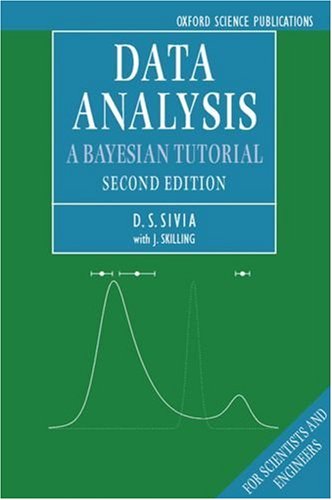

Most ebook files are in PDF format, so you can easily read them using various software such as Foxit Reader or directly on the Google Chrome browser.
Some ebook files are released by publishers in other formats such as .awz, .mobi, .epub, .fb2, etc. You may need to install specific software to read these formats on mobile/PC, such as Calibre.
Please read the tutorial at this link. https://ebooknice.com/page/post?id=faq
We offer FREE conversion to the popular formats you request; however, this may take some time. Therefore, right after payment, please email us, and we will try to provide the service as quickly as possible.
For some exceptional file formats or broken links (if any), please refrain from opening any disputes. Instead, email us first, and we will try to assist within a maximum of 6 hours.
EbookNice Team

Status:
Available4.6
15 reviews
ISBN 10: 0198568320
ISBN 13: 9780198568322
Author: Devinderjit Sivia, John Skilling
Statistics lectures have been a source of much bewilderment and frustration for generations of students. This book attempts to remedy the situation by expounding a logical and unified approach to the whole subject of data analysis. This text is intended as a tutorial guide for senior undergraduates and research students in science and engineering. After explaining the basic principles of Bayesian probability theory, their use is illustrated with a variety of examples ranging from elementary parameter estimation to image processing. Other topics covered include reliability analysis, multivariate optimization, least-squares and maximum likelihood, error-propagation, hypothesis testing, maximum entropy and experimental design. The Second Edition of this successful tutorial book contains a new chapter on extensions to the ubiquitous least-squares procedure, allowing for the straightforward handling of outliers and unknown correlated noise, and a cutting-edge contribution from John Skilling on a novel numerical technique for Bayesian computation called 'nested sampling'.
1. The basics
1.1 Introduction: deductive logic versus plausible reasoning
1.2 Probability: Cox and the rules for consistent reasoning
1.3 Corollaries: Bayes’ theorem and marginalization
1.4 Some history: Bayes, Laplace and orthodox statistics
1.5 Outline of book
2. Parameter estimation I
2.1 Example 1: is this a fair coin?
2.2 Reliabilities: best estimates, error-bars and confidence intervals
2.3 Example 2: Gaussian noise and averages
2.4 Example 3: the lighthouse problem
3. Parameter estimation II
3.1 Example 4: amplitude of a signal in the presence of background
3.2 Reliabilities: best estimates, correlations and error-bars
3.3 Example 5: Gaussian noise revisited
3.4 Algorithms: a numerical interlude
3.5 Approximations: maximum likelihood and least-squares
3.6 Error-propagation: changing variables
4. Model selection
4.1 Introduction: the story of Mr A and Mr B
4.2 Example 6: how many lines are there?
4.3 Other examples: means, variance, dating and so on
5. Assigning probabilities
5.1 Ignorance: indifference and transformation groups
5.2 Testable information: the principle of maximum entropy
5.3 MaxEnt examples: some common pdfs
5.4 Approximations: interconnections and simplifications
5.5 Hangups: priors versus likelihoods
PART II: ADVANCED TOPICS
6. Non-parametric estimation
6.1 Introduction: free-form solutions
6.2 MaxEnt: images, monkeys and a non-uniform prior
6.3 Smoothness: fuzzy pixels and spatial correlations
6.4 Generalizations: some extensions and comments
7. Experimental design
7.1 Introduction: general issues
7.2 Example 7: optimizing resolution functions
7.3 Calibration, model selection and binning
7.4 Information gain: quantifying the worth of an experiment
8. Least-squares extensions
8.1 Introduction: constraints and restraints
8.2 Noise scaling: a simple global adjustment
8.3 Outliers: dealing with erratic data
8.4 Background removal
8.5 Correlated noise: avoiding over-counting
8.6 Log-normal: least-squares for magnitude data
9. Nested sampling
9.1 Introduction: the computational problem
9.2 Nested sampling: the basic idea
9.3 Generating a new object by random sampling
9.4 Monte Carlo sampling of the posterior
9.5 How many objects are needed?
9.6 Simulated annealing
10. Quantification
10.1 Exploring an intrinsically non-uniform prior
10.2 Example: ON/OFF switching
10.3 Estimating quantities
10.4 Final remarks
A. Gaussian integrals
A.1 The univariate case
A.2 The bivariate extension
A.3 The multivariate generalization
B. Cox’s derivation of probability
B.1 Lemma 1: associativity equation
B.2 Lemma 2: negation
Bibliography
Index
data analysis a bayesian tutorial pdf
bayesian data analysis book
data analysis a bayesian tutorial
bayesian data analysis pdf
bayesian data analysis example
a bayesian tutorial for data assimilation
Tags: Devinderjit Sivia, John Skilling, Analysis, Bayesian